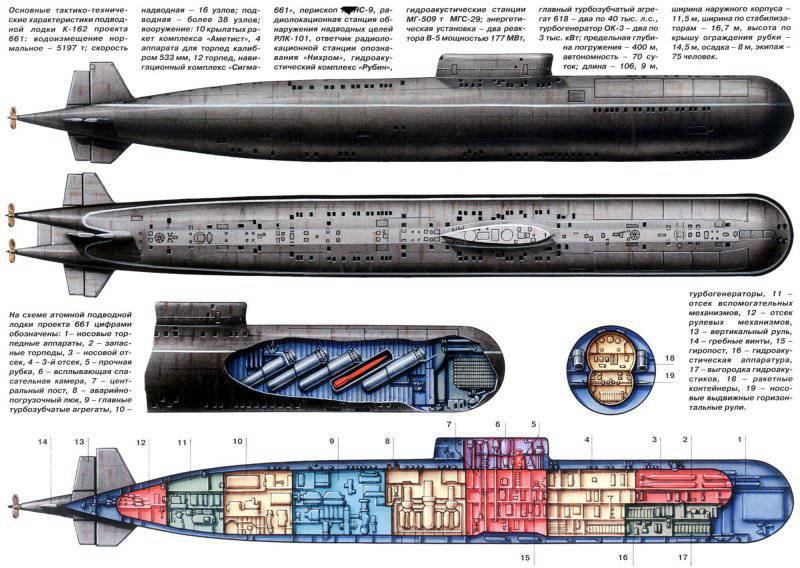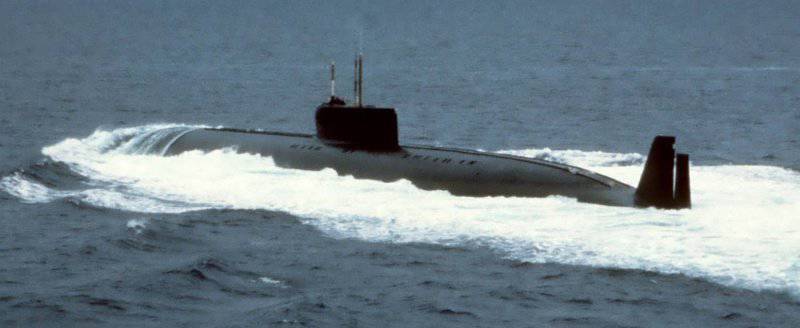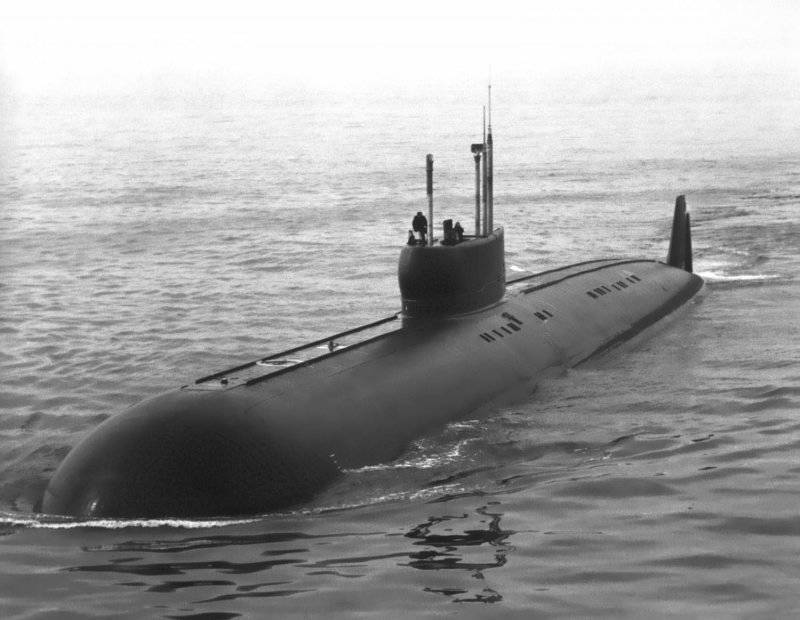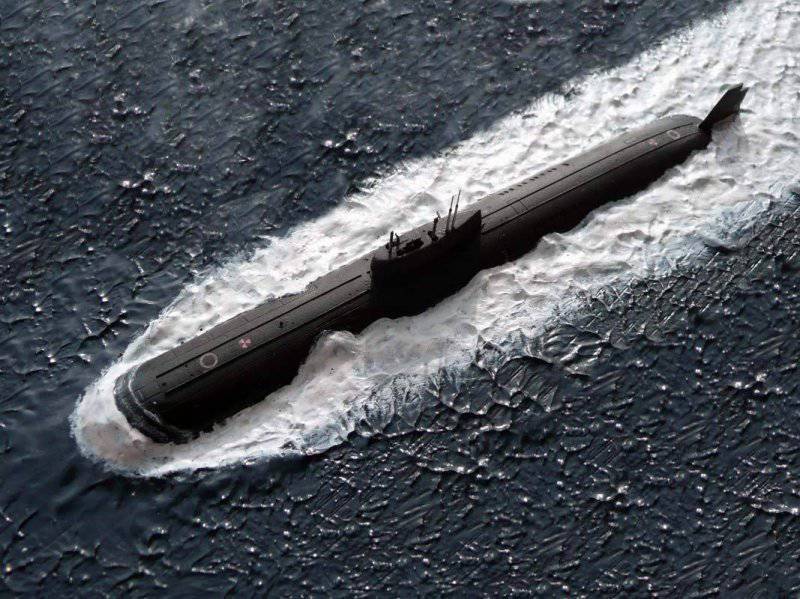Nuclear submarines with cruise missiles. 661 project

The TsKB-16 State Committee for Shipbuilding (today - SPMBM "Malachite") under this decree began the development of high-speed nuclear submarine 661-th project (code "Anchar"). The management of the shipbuilding industry considered the work on this topic as top priority.
The combat mission of the submarine was the fight against high-speed escort ships and aircraft carriers.
The Central Scientific Research Institute No. XXUMX (today the Central Scientific Research Institute named after Academician Krylov) actively participated in the work on the 661 project. The Institute investigated not only “ship” issues that are associated with the creation of a new nuclear submarine, but also questions of the effectiveness of the high-speed submarine.
Three structural materials were considered for use in the manufacture of robust hulls - titanium, aluminum or steel. In the end, we decided to choose titanium. This made it possible to reduce the weight of the hull and, consequently, the displacement of the submarine. Thus, one of the important unmasking signs of the submarine, the magnetic field, was significantly reduced.
After two types of reactors were considered — a simpler and more advanced water-to-water and promising liquid metal (primary coolant — bismuth-lead alloy) —the first was chosen as the most realistic in terms of production, although it had somewhat worse specific parameters.
Worked 14 basic and 6 additional options pre-sketch project. In addition, they considered alternative options for submarine armament: Amethyst cruise missiles launched from under water, developed under the guidance of Chelomey, General Designer, cruise missiles launched from a surface position (Beriev’s Chief Designer) or high-powered torpedoes, which were under development at that time. .
The choice of the main armament required a comparative evaluation of the effectiveness of various nuclear submarine variants. As a result of studies that were conducted at TsNII-45, preference was given to the version equipped with Amethyst missiles. A government decree on the development of the world's first cruise missile, having an underwater launch, was released 01.04.1959, and already on April 9 approved the sub-draft of the submarine.
The development of those. The project of a nuclear submarine with cruise missiles project 661 ended in December 1960 year. The combination of powerful nuclear energy and new hull lines provided the submarine with unique speed characteristics. In accordance with the project, the submarine had to reach a maximum speed in the submerged position near the 38 nodes, which exceeded the submarine speed of any US Navy combat ship.
The project manager of the SSAR was the chief designer N.N. Isanina (later replaced by Shulzhenko). The main observer from the naval fleet was Yu.G. Ilyinsky, who was later replaced by V.N. Markov. This program involved more than 400 enterprises and organizations.
During the design and construction of the submarine, the technology of welding of hull structures made of titanium high-strength alloys, the manufacture of reinforcement, forgings, castings and other products from them were worked out. At the Northern Machine-Building Enterprise, to work with a titanium alloy, it was necessary to create a spec. workshops and other premises.
For carrying out dynamic and static tests, they made semi-cavity sections DMT60-2 (tested at a marine testing ground) and SMT60-1 (tested in a docking chamber).
On Severmash in 1962, the manufacture of the first shells and frames of the solid hull of a submarine of the 661 project began. However, the first tests of body elements made of titanium alloy were unsuccessful, it took extra. works As a result, only 661 in Severodvinsk made the official launch of the submarine of the 28.12.1963 project.
The high degree of complexity and novelty of the project determined the long-term implementation of the work. Work on the creation of the vessel lasted more than 11 years. The slow pace of deliveries of titanium, which was scarce for that time, in which rocketry and aircraft industry were also in dire need, had an effect on the delay in construction. As a result, the submarine, which received the tactical number K-162, launched only 21.12.1968. On the running tests of the factory she went 13.12.1969.
During testing at 92 percent power plant at a landfill with relatively shallow depths (water depth - 200 meters, stroke depth - 100 meters) the maximum underwater speed in the 42 node was obtained, which significantly exceeded the calculated parameters, which were equal to 38 nodes. Thus, they set a world speed record for submarines, previously held by the 671 project ships (33,5 node). The fastest US nuclear submarines developed the speed of 30 nodes. Later, when the main power plant reached full capacity and in a deeper water area, an even higher result was obtained - the 44,7 node (during the forcing of the power installation, the speed of more than 45 nodes was briefly achieved). This is still the absolute record speed for submarines.
Nuclear submarines with cruise missiles of the 661 project had a double-shell architecture. Titanium durable case, was divided into nine compartments:
The first (upper) and second (lower) compartments, which in the section had the shape of a figure of eight, formed by two intersecting 5,9-meter circles (they contained torpedo tubes, spare ammunition and a fast-loading device);
The third compartment served to accommodate the living room, mess-room, food unit and batteries;
The fourth compartment - the central post, power plant control post, residential unit;
Fifth reactor compartment;
Turbine compartment six;
The seventh compartment turbogenerator;
The eighth compartment served for installation of auxiliary mechanisms (compressor machines, refrigerators, water desalination plant);
The ninth compartment is a bilge post and steering gears.
The aft end of the submarine was made forked in the form of two conical axially symmetric shaft fairings. The distance between them was about 5 meters (in everyday life this decision was called “pants”). Hydrodynamic optimization of the aft tip was achieved due to elongation of the waterline with small angles in the centerline and the use of elongated propeller shafts with fairings that allow the installation of propellers of the required diameter for a given rotational speed.
Power plant capacity 80 thousand l. with. included a pair of autonomous groups (left and right sides). Each group consisted of a B-5P nuclear power plant, a GTPA-618 turbo-gear, an autonomous three-phase alternating current turbine generator OK-3 (power 3 thousand kW). Thermal rated power of each of the two water-water nuclear reactors 177,4 MW. The steam capacity of each PUF at normal power is 250 tons of steam per hour.
Developed for the submarine 661-th project, the reactors had several original features. For example, the pumping of the primary coolant was carried out according to the “pipe in pipe” scheme. This technology ensured the compactness of a nuclear power plant at high thermal stresses. Reactors at the same time worked both on thermal neutrons, and with the participation of the fission reaction of fast neutrons.
An alternating three-phase current with a frequency of 50 Hz and a voltage of 380 B was adopted to power the consumers. A major innovation was the rejection of the use of diesel generators: an emergency source of current was a high-capacity rechargeable battery.
Onboard the submarine there was a Sigma-661, an all-latitude navigational complex that provided sub-ice and scuba diving.
The ship was automatically controlled using depth and heading control systems Spar, preventing Tourmaline crashes and differentials, and controlling general shipboard systems, outboard openings and Signal-661 devices.
SJC MGK-300 "Rubin" made it possible to detect noisy targets with automatic simultaneous tracking of two. In this case, the data were issued to the control systems of torpedo and rocket weapons. Circular detection of enemy hydroacoustic signals, which work in active mode and their identification with determination of distance and bearing, was provided. The ship was equipped with a sonar system "Radian-1" serving to detect anchor mines.
To monitor the surface and air situation, the submarine was equipped with the PNZ-9 aperture flare-up periscope equipped with an optical coordinate transmitter. Using a lifting device, the periscope could rise from a depth of less than 30 meters with waves of up to 5 points and speeds of less than 10 nodes. There were radar systems MTP-10 and RLK-101, as well as the system "Nichrome" - a system for determining the state. accessories.
For ultra-high-speed two-way secret radio communication with coastal controls, airplanes and ships interacting with the submarine, there was modern (by the standards of that time) radio communication equipment. The submarine was equipped with a radio intelligence system that provides detection, search and detection of enemy radio stations in operation.
The main armament is the Amethyst anti-ship missile system with ten cruise missiles, which were located in inclined containers located outside the strong hull of the port. The maximum firing range - 70 th. M.
The rockets were launched from a submerged position from a pre-flooded container from depths to 30 meters. Immediately after exiting the container, the starting engine worked, and the wing opened, after which the sustainer solid-fuel engine was turned on in the surface position.
Also in the composition of the missile complex was the equipment of the pre-launch control, the instruments of the ship’s missile control systems associated with the SAC, the complex for controlling the navigation complex, torpedo firing, as well as the stabilizer for controlling the depth and course.
The launcher provided storage, transportation, remote pre-launch preparation and launch of the CD without access to the container. Cruise missiles were taken aboard the submarine in the final curb condition for launch. Secure storage of the missiles and their launch during the three months of their stay in the campaign was ensured.
All rocket ammunition was produced in two volleys. The interval between them was three minutes (experts believed that this was a significant tactical flaw in the project, which hampered the effective use of nuclear-powered submarines with cruise missiles for their main objectives, that is, enemy aircraft carriers).
4 torpedo tubes of caliber 533 mm were placed in the nose of the submarine (total ammunition was 12 torpedoes), providing fire from depths less than 200 meters. To control the torpedo firing served as an automated system "Ladoga-P-661".
Technical characteristics of the nuclear submarine with cruise missiles project 661:
The greatest length - 106,9 m;
The greatest width - 11,5 m;
Average draft - 8,1 m;
Normal displacement - 5197 m3;
Full displacement - 7000 m3;
Extreme depth of immersion - 400 m;
Maximum submerged speed - node 44,7;
Surface speed - 19,0 nodes;
Autonomy - 70 days;
Crew - 80 man.
On tests, the K-162 submarine demonstrated excellent maneuverability in horizontal and vertical planes. Possessing unique maneuverability and speed characteristics, combined with a powerful HOOK, which has a long detection range, the nuclear submarine with cruise missiles of the 661 project was able to carry out rapid deployment in a combat area and select a vantage point to use weapons and make a second attack. , which expanded the combat capabilities of the vessel in comparison with nuclear submarines of other projects.
The boat was a kind of laboratory, where, under natural conditions, new types of weapons and weapons were tested. Much of what was created for this experimental submarine was later used on new submarines of other projects.
The pilot operation of the submarine began in 1970 and ended in December 1971. In September of the same year, K-162 entered military service, during which the submarine passed to the equator up to the Brazil depression from the Greenland Sea. In the course of this transition, the submarine performed a number of tasks together with surface ships and other submarines. The Saratoga aircraft carrier was escorted. At the same time, the US Navy tried several times to break away from the submarine, developing a speed greater than 30 nodes, but failed to achieve the desired result. In addition, the nuclear submarine, carrying out maneuvers, sometimes ahead of the American ship. During the two and a half months of the trip, the boat climbed to the surface only once.
K-162 after the completion of trial operation in Severodvinsk underwent repairs. In 1974, she returned to the Navy.
In the West, the submarine of the 661 project received the name "Papa". In the Soviet navy, the submarine was called the “Golden Fish” (formerly the nuclear submarine of the 645 project used to carry this prestigious nickname).
Initially it was assumed that after the head (experienced) submarine of the 661 project was built, the 10 tab of serial ships of this type would follow. However, in the future, the number of serial submarines with cruise missiles was reduced to five, later to three, and in the new five-year plan adopted in the 1964 year, it was generally decided to limit the construction of a single submarine of the 661 project. This decision was largely due to the lack of titanium in the country and technological difficulties that delay the construction of a unique ship.
V1970 was again discussing the question of laying a series of improved submarines with the KR - project 661M. Worked three versions of the submarine, differing in displacement (5197 - 6208 tons), underwater speed (from 39 to 42 nodes), main power installation (from 43000 to 55000 hp) and other parameters. But by this time they had launched serial construction of not so high-speed characteristics, but much lower noise and cheaper submarines of the 670 project, which had comparable strike power. Also, it was required to make significant changes to the missile fire control system of the SSGN of the 661 project.
The fleet did not satisfy the high noise of the submarine when moving under water. The increased level of acoustic noise caused difficulties in the work of the SJC. Under these conditions, it was decided to abandon the mass production of nuclear submarines based on the 661 project. Proposals for the modernization of the K-162 submarine, which included the installation of the P-120 missile system with a further replacement with the Granit complex, also did not receive development.
The SSGT K-162 in 1978 was renamed K-222. As part of the Northern Fleet, K-222 was located up to 1988, after which it was taken to the reserve, and later transferred to recycling.




Information